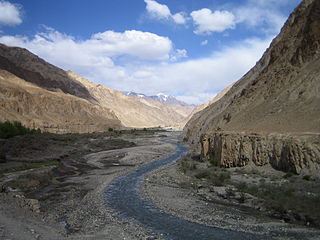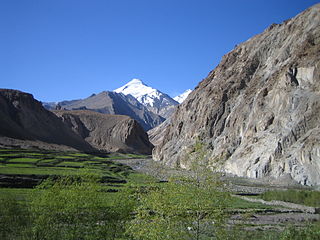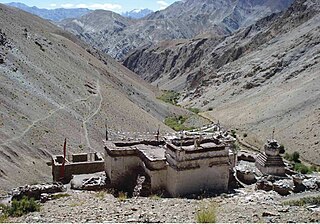
Ladakh is a region administered by India as a union territory and constitutes an eastern portion of the larger Kashmir region that has been the subject of a dispute between India and Pakistan since 1947 and India and China since 1959. Ladakh is bordered by the Tibet Autonomous Region to the east, the Indian state of Himachal Pradesh to the south, both the Indian-administered union territory of Jammu and Kashmir and the Pakistan-administered Gilgit-Baltistan to the west, and the southwest corner of Xinjiang across the Karakoram Pass in the far north. It extends from the Siachen Glacier in the Karakoram range to the north to the main Great Himalayas to the south. The eastern end, consisting of the uninhabited Aksai Chin plains, is claimed by the Indian Government as part of Ladakh, but has been under Chinese control.

Hemis National Park is a high-elevation national park in Hemis in Leh district of Ladakh, India. It approx. 50 km from Leh, the capital of Ladakh. Globally famous for its snow leopards, it is believed to have the highest density of them in any protected area in the world. It is the only national park in India that is north of the Himalayas, the largest notified protected area in India and is the second largest contiguous protected area, after the Nanda Devi Biosphere Reserve and surrounding protected areas. The park is home to a number of species of endangered mammals, including the snow leopard. Hemis National Park is India's protected area inside the Palearctic realm, outside the Changthang Wildlife Sanctuary northeast of Hemis, and the proposed Tso Lhamo Cold Desert Conservation Area in North Sikkim.

Padum is the main town and the administrative centre of the Zanskar tehsil in Kargil district, Ladakh, India. Named after the Buddhist guru Padmasambhava, it was historically one of the two main capitals of the Zanskar Kingdom, the other being Zangla. It is 235 km (146 mi) via the link road from Kargil city. The new Nimmu–Padum–Darcha road connects Padum directly to Leh in the east and to Darcha in Himachal Pradesh.

Alchi is a village in the Leh district of Ladakh, India. It is located in the Likir tehsil, on the banks of the Indus River 70 km downstream from the capital Leh. Unlike the other gompas in Ladakh, Alchi is situated on lowland, not on a hilltop.

Tourism is one of the economic contributors to the union territory of Ladakh in Northern India. The union territory is sandwiched between the Karakoram mountain range to the north and the Himalayas to the south, and is situated at a height of 11,400 ft. Ladakh is composed of Leh and Kargil districts. The region contains prominent Buddhist sites and has an ecotourism industry.

Hemis, also spelled Hamis, is a village in the Leh district of Ladakh, India. It is located in the Kharu tehsil, 40 km southeast of Leh town on the Leh-Manali Highway and under-construction Bhanupli–Leh line.

The Zanskar River is the first major tributary of the Indus River, equal or greater in volume than the main river, which flows entirely within Ladakh, India. It originates northeast of the Great Himalayan range and drains both the Himalayas and the Zanskar Range within the region of Zanskar. It flows northeast to join the Indus River near Nimo.

Hemis Monastery is a Himalayan Buddhist monastery (gompa) of the Drukpa Lineage, in Hemis on the bank of the Indus River, Ladakh, India. Situated 45 km from Leh, it was re-established in 1672 by the Ladakhi king Sengge Namgyal. The annual Hemis festival honouring Padmasambhava is held there in early June.

Stok Kangri is the highest mountain in the Stok Range of the Zazkar Mountains a Trans-Himalayan mountain in the Ladakh region of north India. The peak is located in Hemis National Park, 12 km southwest of the trailhead in the village of Stok and around 15 km southwest of the city of Leh, the capital of Ladakh.

Lingshed Monastery or Lingshed Gompa is a Gelugpa Buddhist monastery in Ladakh, India. It is located near Lingshet village in the Leh district. It is 84 km north of Padum. It was founded in the 1440s by Changsems Sherabs Zangpo, disciple of Je Tsongkhapa, on a monastic site previously founded by the Translator Rinchen Zangpo. The monastery has belonged to the religious estate of Ngari Rinpoche since 1779. The Jangchub Tensung Dorje Center was founded in Lingshed by Kyabje Dagom Rinpoche in 1994.

The Markha River is a river in Ladakh, India. It is a tributary of the Zanskar River and starts at the junction of the Langtang Chu and Nimaling Chu. Villages along the river valley include Skiu (Skyu), Markha, Umlung and Hangkar (Hankar). The Markha River lies within the Hemis National Park.

Kang Yatze or Kang Yatse is a mountain located at the end of the Markha valley in the Himalayas in the Ladakh region of northwest India. It is located in the Hemis National Park.

Temple at Sumda Chun, an early Tibetan Buddhist temple and monastery is located in the Sumda Chun village, on northwest edge of Leh in Himalayas in Ladakh, India.

Chumathang is a village in Leh District, Ladakh in northern India on the banks of the Indus River. Chumathang village is among the first villages in the Changthang region to have its own power station and government high school which was only possible under the guidance of Mr Gonbo. Famous for its hot spring which attracts many tourists all over the world, even the local people come every year to take the medicinal benefits from the hot spring. There is an old monastery or gonpa which is located near the road which is about more than 400 years old and is among the oldest monasteries of Ladakh.
All Ladakh Gonpa Association (ALGA) is the central organisation of the Buddhist monasteries in Ladakh, India. It aims to preserve and strengthen the monastic institutions. It was founded by the 19th Kushok Bakula Rinpoche in 1949 and he acted as its president for 41 years, from 1949 until 1991. In 1949, the first meeting of the great monasteries was held and ten monasteries took part. All Ladakh Gonpa Association was registered in 1959 and is run by a governing body consisting of fifteen lama members belonging to all four major schools of Tibetan Buddhism. There are sixteen major monastic institutions with hundreds of monks in each monastery.

Demchok , previously called New Demchok, and called Parigas by the Chinese, is a village and military encampment in the Indian-administered Demchok sector, that is disputed between India and China. It is administered as part of the Nyoma tehsil in the Leh district of Ladakh by India, and claimed by China as part of the Tibet Autonomous Region.
Rumbak is a village in the Leh district of Ladakh, India. It is located in the Likir tehsil and lies within Hemis National Park.
The Charding Nullah, traditionally known as the Lhari stream and called Demchok River by China, is a small river that originates near the Charding La pass that is also on the border between the two countries and flows northeast to join the Indus River near a peak called "Demchok Karpo" or "Lhari Karpo". There are villages on both sides of the mouth of the river called by the same name "Demchok", which is presumed to have been a single village originally, and has gotten split into two due to geopolitcal reasons. The river serves as the de facto border between China and India in the southern part of the Demchok sector.

Nimmu–Padum–Darcha road or Zanskar Highway is a road between the Indian union territory of Ladakh and the state of Himachal Pradesh, passing through the region of Zanskar. It connects Nimmu in the Indus Valley to Padum, the capital of Zanskar, and to Darcha village in Lahul and Spiti. It provides an alternative to the Leh–Manali Highway in linking Ladakh with the rest of India. It was built by the Border Roads Organisation (BRO) of the Indian Army. The construction of road was completed in March 2024. The already completed Atal tunnel, and the proposed unidirectional-twin-tube total-4-lane Shingo La Tunnel, which is expected to be completed by 2025 will provide all weather connectivity and reduce the distance from Manali to Kargil by 522 km.

The culture of Ladakh refers to the traditional customs, belief systems, and political systems that are followed by Ladakhi people in India. The languages, religions, dance, music, architecture, food, and customs of the Ladakh region are similar to neighboring Tibet. Ladakhi is the traditional language of Ladakh. The popular dances in Ladakh include the khatok chenmo, cham, etc. The people of Ladakh also celebrate several festivals throughout the year, some of the most famous are Hemis Tsechu and Losar.


















